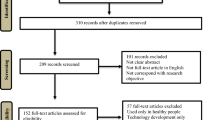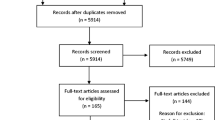Abstract
Background
Novice surgeons experience high levels of physical and mental workload during the early stages of their curriculum and clinical practice. Laparoscopic sleeve gastrectomy is the first bariatric procedure worldwide. Feasibility and safety of single-port sleeve gastrectomy (SPSG) has been demonstrated. An immersive virtual reality (VR) simulation was developed to provide a repetitive exercise to learn this novel technique. The primary objective of this study was to evaluate the impact of the VR training tool on mental and physical workload in novice surgeons. The secondary objective included an evaluation of the VR simulator.
Methods
A monocentric-controlled trial was conducted. Ten participants were divided into two groups, the VR group and the control group (without VR training). Surgery residents participated in a first real case of SPSG and a second case 1 month later. The VR group underwent a VR training between the two surgeries. Mental and physical loads were assessed with self-assessment questionnaires: NASA-TLX, Borg scale, and manikin discomfort test. The VR simulator was evaluated through presence, cybersickness, and usability questionnaires.
Results
This study showed a decrease of the mental demand and effort dimensions of NASA-TLX between the first and the second surgery in the VR group (P < .05). During the second surgery, a marginally significant difference was shown concerning the mental demand between the two groups. Postural discomfort of the VR group decreased with practice (P < .01), mainly between the first and the second surgery (P < .05). Furthermore, participants characterized the VR simulator as realistic, usable, and very useful to learned surgery.
Conclusion
This exploratory study showed an improvement in mental and physical workload when novice surgeons trained with VR (repetitive practice, gesture improvement, reduction of stress, etc.). Virtual reality appears to be a promising perspective for surgical training.





Similar content being viewed by others
Notes
In NASA-TLX, performance is the only dimension with an inverse range, the scale going from good (0) to poor (100), while in other dimensions, the scale going from low (0) to high (100). RTLX score was used in this study [27].
Postural discomfort score is based on manikin body part of Corlett and Bishop [16]. Here, the score range from 0 to 10, with 0 being none discomfort and 10 extreme discomfort.
The PQ measure is divided in seven categories: realism (seven questions), possibility to act/control (four questions), quality of interface (three questions), possibility to examine (three questions), self-efficacy/performance (two questions), sounds (not evaluated here), and haptic (two questions). The questionnaire contains 21 items and is measured through an 8-point semantic differential scale (e.g., from “not at all” to “completely”).
Augmented reality (AR) & virtual reality (VR) in Healthcare Market Report, 2025. Available from https://www.grandviewresearch.com/industry-analysis/virtual-reality-vr-in-healthcare-market.
References
Arora S, Sevdalis N, Aggarwal R, et al. Stress impairs psychomotor performance in novice laparoscopic surgeons. Surg Endosc. 2010 Oct;24(10):2588–93.
Klein MI, Warm JS, Riley MA, et al. Mental workload and stress perceived by novice operators in the laparoscopic and robotic minimally invasive surgical interfaces. J Endourol. 2012 Aug;26(8):1089–94.
Ma M, Jain LC, Anderson P. Virtual, augmented reality and serious games for healthcare 1. Berlin: Springer; 2014.
Khor WS, Baker B, Amin K, et al. Augmented and virtual reality in surgery—the digital surgical environment: applications, limitations and legal pitfalls. Ann Transl Med. 2016 Dec;4(23):454.
Gebara CM, Barros-Neto TPD, Gertsenchtein L, et al. Virtual reality exposure using three-dimensional images for the treatment of social phobia. Rev Bras Psiquiatr. 2016 Mar;38(1):24–9.
Son JH, Lee SH, Seok JW, et al. Virtual reality therapy for the treatment of alcohol dependence: a preliminary investigation with positron emission tomography/computerized tomography. J Stud Alcohol Drugs. 2015 Jul;76(4):620–7.
Hoffman HG. Virtual-reality therapy. Sci Am. 2004 Aug;291(2):58–65.
García-Betances RI, Arredondo Waldmeyer MT, Fico G, et al. A succinct overview of virtual reality technology use in Alzheimer’s disease. Front Aging Neurosci. 2015 May;7(80):1–8.
Lin CY, Chang YM. Interactive augmented reality using Scratch 2.0 to improve physical activities for children with developmental disabilities. Res Dev Disabil. 2015 Feb;37:1–8.
Alhabdan S, Alamri H, Aggarwal R. Opportunities for education and training in bariatric surgery: a systematic review. Surg Obes Relat Dis. 2016 Aug;12(7):S147–8.
Pulijala Y, Ma M, Pears M, et al. Effectiveness of immersive virtual reality in surgical training—a randomized control trial. J Oral Maxillofac Surg. 2018 May;76(5):1065–72.
Pourcher G, Ferretti S, Akakpo W, et al. Single-port sleeve gastrectomy for super-obese patients. Surg Obes Relat Dis. 2016 Mar-Apr;12(3):522–7.
Pourcher G, Di Giuro G, Lafosse T, et al. Routine single-port sleeve gastrectomy: a study of 60 consecutive patients. Surg Obes Relat Dis. 2013 May-Jun;9(3):385–9.
Hart SG, Staveland LE. Development of NASA-TLX (task load index): results of empirical and theoretical research. Adv Psychol. 1988;52:139–83.
Borg GA. Psychophysical bases of perceived exertion. Med Sci Sports Exerc. 1982;14(5):377–81.
Corlett EN, Bishop RP. A technique for assessing postural discomfort. Ergonomics. 1976;19(2):175–82.
Steuer J. Defining virtual reality: dimensions determining telepresence. J Commun. 1992;42(4):73–93.
Nash EB, Edwards GW, Thompson JA, et al. A review of presence and performance in virtual environments. Int J Hum Comput Interact. 2000;12(1):1–41.
Mantovani F, Castelnuovo G. The sense of presence in virtual training: enhancing skills acquisition and transfer of knowledge through learning experience in virtual environments. In: Riva G, Davide F, IJsselsteijn WA, editors. Being there: concepts, effects and measurement of user presence in synthetic environments. Amsterdam, Netherland: Ios Press; 2003. p. 168–81.
Witmer BG, Singer MJ. Measuring presence in virtual environments: a presence questionnaire. Presence. 1998;7(3):225–40.
Hill KJ, Howarth PA. Habituation to the side effects of immersion in a virtual environment. Displays. 2000;21(1):25–30.
Nichols S, Patel H. Health and safety implications of virtual reality: a review of empirical evidence. Appl Ergon. 2002;33(3):251–71.
Kennedy RS, Lane NE, Berbaum KS, et al. Simulator sickness questionnaire: an enhanced method for quantifying simulator sickness. Int J Aviat Psychol. 1993;3(3):203–20.
Brooke J. SUS-A quick and dirty usability scale. Usability evaluation in industry. 1996;189(194):4–7.
Azmandian M, Hancock M, Benko H, et al. Haptic retargeting: dynamic repurposing of passive haptics for enhanced virtual reality experiences. Proceedings of the CHI’16 conference on human factors in computing systems. 2016:1968–79.
Shewaga R, Uribe-Quevedo A, Kapralos B, et al. Comparison of seated and room-scale virtual reality in a serious game for epidural preparation. In: IEEE transactions on emerging topics in computing; 2017. p. 1–14.
Byers JC, Bittner AC, Hill SG. Traditional and raw task load index (TLX) correlations: are paired comparisons necessary? In: Mital A, editor. Advances in industrial ergonomics and safety. London: Taylor & Francis; 1989. p. 481–5.
Bouchard S, Robillard G, Renaud P, et al. Exploring new dimensions in the assessment of virtual reality induced side effects. J Comput Inf Technol. 2011;1(3):20–32.
Bangor A, Kortum P, Miller J. Determining what individual SUS scores mean: adding an adjective rating scale. J Usability Stud. 2009;4(3):114–23.
Rosen KR. The history of medical simulation. J Crit Care. 2008 Jun;23(2):157–66.
Moorthy K, Munz Y, Forrest D, et al. Surgical crisis management skills training and assessment: a stimulation-based approach to enhancing operating room performance. Ann Surg. 2006 Jul;244(1):139–47.
Chang TP, Gerard J, Pusic MV. Screen-based simulation, virtual reality, and haptic simulators. In: Grant VJ, Cheng A, editors. Comprehensive healthcare simulation: pediatrics: Springer; 2016. p. 105–14.
Yiannakopoulou E, Nikiteas N, Perrea D, et al. Virtual reality simulators and training in laparoscopic surgery. Int J Surg. 2015 Jan;13:60–4.
Botden SM, Jakimowicz JJ. What is going on in augmented reality simulation in laparoscopic surgery? Surg Endosc. 2009 Aug;23(8):1693–700.
Huber T, Paschold M, Hansen C, et al. New dimensions in surgical training: immersive virtual reality laparoscopic simulation exhilarates surgical staff. Surg Endosc. 2017 Nov;31(11):4472–7.
Huber T, Wunderling T, Paschold M, et al. Highly immersive virtual reality laparoscopy simulation: development and future aspects. Int J Comput Assist Radiol Surg. 2018 Feb;13(2):281–90.
Zheng B, Jiang X, Tien G, et al. Workload assessment of surgeons: correlation between NASA TLX and blinks. Surg Endosc. 2012 Oct;26(10):2746–50.
Elhage O, Challacombe B, Shortland A, et al. An assessment of the physical impact of complex surgical tasks on surgeon errors and discomfort: a comparison between robot-assisted, laparoscopic and open approaches. BJU Int. 2015 Feb;115(2):274–81.
Paige JT, Yu Q, Hunt JP, et al. Thinking it through: mental rehearsal and performance on 2 types of laparoscopic cholecystectomy simulators. J Surgical Educ. 2015 Jul-Aug;72(4):740–8.
Author information
Authors and Affiliations
Corresponding author
Ethics declarations
Conflict of Interest
The authors declare that they have no conflict of interest.
Ethical Approval Statement
All procedures performed in studies involving human participants were in accordance with the ethical standards of the institutional and/or national research committee and with the 1964 Helsinki declaration and its later amendments or comparable ethical standards.
Informed Consent Statement
Informed consent was obtained from all individual participants included in the study.
Additional information
Publisher’s Note
Springer Nature remains neutral with regard to jurisdictional claims in published maps and institutional affiliations.
Rights and permissions
About this article
Cite this article
Barré, J., Michelet, D., Truchot, J. et al. Virtual Reality Single-Port Sleeve Gastrectomy Training Decreases Physical and Mental Workload in Novice Surgeons: An Exploratory Study. OBES SURG 29, 1309–1316 (2019). https://doi.org/10.1007/s11695-018-03680-9
Published:
Issue Date:
DOI: https://doi.org/10.1007/s11695-018-03680-9




